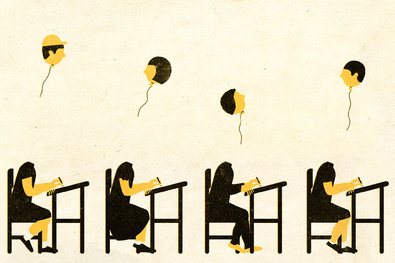
Is the A.D.H.D. Diagnosis Helping or Hurting Kids?
The skyrocketing number of children with attention deficit disorders has led some pediatricians to question whether the diagnostic criteria for them — which is necessary for medication prescriptions and disability accommodations — is too subjective. Some children may be over-diagnosed and over-medicated, while others who fall short of the diagnosis go unsupported. Are attention deficit diagnoses helping or hurting kids?
* skyrocketing = 치솟는/ attention deficit disorder = 주의력 결핍 장애/ pediatrician = 소아과 의사/ diagnostic = 진단의/ criteria(단수 = criterion) = 규준, 표준, 기준/ medication = 약[약물] (치료)/ prescription = 처방전/ accommodation = 시설/ subjective = 주관적인/ fall short of ~ = (예상되는, 필요한 기준인) ~에 미치치 못하다
 주의력 결핍 진단이 아이들에게 도움이 되나요, 피해를 주나요?
주의력 결핍 진단이 아이들에게 도움이 되나요, 피해를 주나요?
1. The Diagnosis Does a Disservice
Our current diagnostic approaches are too black and white for a disorder that exists on a spectrum.
2. Diagnosis Is Key to Helping Kids
Strong scientific evidence correlates A.D.H.D. with dire health and well-being consequences, which can be alleviated with treatment.
3. Worrying Disparities in Diagnosis of Black and White Children
Though they are more likely to experience symptoms of A.D.H.D., children of color are less likely to receive treatment or diagnosis.
4. Don’t Rush to Saddle Children With the A.D.H.D. Label
Even when drugs are truly required, students still need strategies to help them pay attention and adjust their behavior when they have lots of energy.
5. Failure to Conform Accounts for Most Diagnoses
Children often get diagnosed not because they experience impairment but because they are difficult to manage.
Sample Essay
Don’t Rush to Saddle Children With the A.D.H.D. Label
Having spent about 25 years in education, I have seen teachers quickly assume that students who are more active than their classmates (and who are more active than their teachers’ tolerance for high activity levels) require medication.
I see too little time devoted to helping such students adjust or to finding intervention strategies to support them. The rush to saddle them with a disorder, with little prior intervention, contributes to misidentification and societal over-medication. Even when drugs are truly required, students still need strategies to help them pay attention and adjust their behavior when they have lots of energy. It's unnerving to hear your student say, “I need my medication to pay attention,” or “I can’t sit still until I have my medication.” I have heard this more times than I want to remember, even from elementary-aged students.
There are several problems that contribute to A.D.H.D. misdiagnosis. The first is the subjective and limited nature of the evaluations used to diagnose an already high-energy population (kids). A checklist of behaviors should not be the only or primary source of an evaluation when so much is at stake. Observation over a period of time and in multiple settings are needed. How active and attentive are students when they are watching TV or playing games, for example? What are they like in places of worship or when they are traveling, and so on? It is worth considering, in every case, how a child changes his or her behavior based on location and time of day.
It is also important to consider the comparison group when determining what counts as “normal.” For example, most students labeled as having A.D.H.D. are males and many are black males. But boys tend to be more active than girls, and African-Americans are known for being movement-oriented, tactile and kinesthetic. This is considered normal and healthy in the African-American community but not necessarily so in schools.
The structure of the school day also needs to be considered when we address the shorter attention spans, disinterest and frustration of students. Hours of seat work, few breaks, lack of recess, and few tactile and kinesthetic activities do not match how many students prefer to learn; it does not reflect their home and community experiences. Schools need to be restructured to be more hands-on. This will help decrease unnecessary referrals, mislabeling and over-medication.
I, for one, would like to see educators examine their tolerance levels for children who require more active days, rather than jump to unnecessary labels and medication.





![]() 주의력 결핍 진단이 아이들에게 도움이 되나요, 피해를 주나요?
주의력 결핍 진단이 아이들에게 도움이 되나요, 피해를 주나요?






